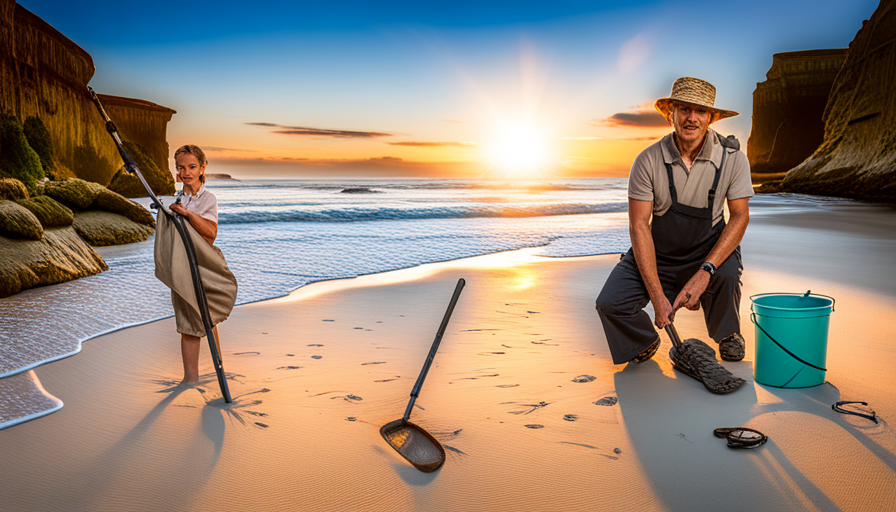Imagine the soft sand beneath your toes, the rhythmic sound of crashing waves, and the warm sun kissing your skin. As a beachcomber, you are on a quest for treasures that lie hidden along the shoreline – beautiful shells waiting to be discovered.
But finding good shells is an art, a skill that requires mastery. In this article, we will share with you five techniques that will elevate your beachcombing game to new heights. By timing your sessions, exploring different beaches, learning to identify shell hotspots, using the right tools and equipment, and practicing the ‘Shuffle and Scan’ technique, you will increase your chances of finding the most exquisite shells.
But beachcombing is not just about the shells; it’s about connecting with nature, experiencing a sense of freedom, and respecting the environment and wildlife that call the beach their home. So, gear up and embark on this beachcombing journey, where the possibilities are as vast as the ocean itself.
Key Takeaways
- Timing beachcombing sessions during low tide increases chances of finding shells.
- Beachcombing after a storm or heavy rainfall brings fresh shells from the deep sea.
- Exploring less crowded and remote beaches increases chances of finding unique shells.
– Using the ‘Shuffle and Scan’ technique helps reveal hidden shells in the sand and increases the variety of shells found.
Time Your Beachcombing Sessions

To maximize your chances of finding exquisite shells, you should time your beachcombing sessions strategically. The best time to go beachcombing is during low tide. This is when the water recedes and exposes more of the beach, giving you a larger area to explore.
Low tide usually occurs twice a day, so it’s important to check the tide charts to plan your beachcombing adventures.
In addition to timing your beachcombing sessions around low tide, it’s also important to consider the beach conditions. Ideally, you want to go beachcombing after a storm or heavy rainfall. This is because storms tend to churn up the ocean, bringing in fresh shells from the deep sea. The rough waves also tend to wash up larger shells onto the shore.
Another factor to consider is the time of day. Early mornings and late afternoons are generally the best times to go beachcombing. This is when the beach is less crowded, allowing you to have more freedom in your search for shells. The sun is also not as intense during these times, making it more comfortable for you to spend hours exploring the beach.
By timing your beachcombing sessions around low tide, considering the beach conditions, and choosing the best time of day, you can greatly increase your chances of finding good shells. So grab your bucket and sunscreen, and head to the beach for a shell-collecting adventure!
Explore Different Beaches

When exploring different beaches for beachcombing, it’s important to look for less crowded areas. This will increase your chances of finding unique and undisturbed shells. Additionally, visiting remote and undeveloped areas will provide you with a greater opportunity to discover hidden treasures that haven’t been touched by other beachcombers.
So, make sure to venture off the beaten path and explore these less explored beaches for a truly rewarding beachcombing experience.
Look for Less Crowded Beaches
Explore the less crowded beaches for an idyllic shell-hunting experience where you can have the beach all to yourself. When searching for good shells, it’s important to consider less crowded beaches as they offer a greater chance of finding untouched treasures.
Not only will you have more space to roam and explore, but you’ll also be able to enjoy the peace and serenity of the beach without the hustle and bustle of crowds.
To make the most of your shell-hunting experience on less crowded beaches, follow these beachcombing etiquette tips:
- Walk lightly and avoid stepping on delicate marine life
- Respect the natural habitat and do not disturb nesting areas or wildlife
- Carry a bag or bucket to collect shells and leave no trace behind
- Be mindful of other beachcombers and maintain a respectful distance
- Enjoy the freedom of solitude and take in the beauty of nature without distractions
By seeking out less crowded beaches and adhering to beachcombing etiquette, you’ll have the perfect opportunity to find exceptional shells while enjoying the tranquility of the beach.
Visit Remote and Undeveloped Areas
For a truly unforgettable experience, venture to remote and undeveloped areas where serenity and untouched beauty await.
Remote beachcombing offers an escape from the crowded tourist destinations, allowing you to immerse yourself in the tranquil surroundings. These hidden treasures are often found in areas that are difficult to access, making them less frequented by beachgoers.
The absence of human activity in these remote locations provides a unique opportunity to discover shells that have been undisturbed for years. As you explore the untouched shorelines, keep an eye out for secluded coves and rocky outcrops, as these are prime spots for finding rare and valuable shells.
The remote beaches hold the promise of finding exquisite shells that have yet to be discovered, enhancing the thrill and sense of freedom that comes with beachcombing.
Learn to Identify Shell Hotspots

To truly become a master beachcomber, you’ll need to develop a keen eye for identifying shell hotspots. These are areas where you’re more likely to find a wide variety of shells.
Here are three key factors to consider when identifying shell hotspots:
- Beach Conditions: Pay attention to the tides, as they can greatly affect the availability of shells. Low tides expose more of the beach, making it easier to spot shells that have washed ashore. Additionally, storms can churn up the ocean, depositing a fresh batch of shells onto the beach.
- Location: Certain areas tend to have more shells than others. Look for beaches with rocky formations or jetties, as they create pockets where shells accumulate. Also, estuaries and river mouths are known to be fruitful spots for shell hunting.
- Marine Life: Keep an eye out for signs of marine life. Shells often gather in areas where there is an abundance of food for animals like crabs and mollusks. Look for areas with seagrass beds or tidal pools, as these can attract a variety of marine life and, subsequently, shells.
By understanding these shell identification tips and the factors that affect shell distribution, you’ll be well-equipped to seek out the best shell hotspots on any beach. Happy beachcombing!
Use the Right Tools and Equipment

Get ready to dive into the world of shell hunting by equipping yourself with the right tools and gear.
Finding the right beachcombing tools and equipment is essential if you want to master the art of finding good shells at the beach. One of the most important tools is a sturdy shell bag or bucket to collect your treasures. Look for one with a mesh bottom to allow sand and water to drain out easily.
A good quality shell scoop or trowel is also essential for digging through the sand and uncovering buried shells. Look for one with a long handle for better reach and a durable metal blade for easy digging. Additionally, a shell rake can be useful for sifting through seaweed and debris to find hidden gems.
Timing is crucial when it comes to beachcombing. The best time to search for shells is during low tide, when more of the beach is exposed and shells are easier to spot. Check local tide charts or use a tide app to plan your beachcombing sessions accordingly.
Remember, beachcombing is all about freedom and enjoying the beauty of nature. So, grab your tools, head to the beach, and let the adventure begin!
Practice the “Shuffle and Scan” Technique

Master the art of shell hunting with the ‘Shuffle and Scan’ technique, a game-changing approach to uncovering hidden treasures on the sandy shores. This technique, when practiced correctly, can significantly increase your chances of finding beautiful and unique shells.
Here are four steps to help you master this technique and become a beachcombing expert:
- Start by shuffling your feet as you walk along the shore. This movement helps to disturb the sand and reveal any hidden shells that may be buried beneath the surface. Be sure to shuffle gently and evenly, as excessive force may damage delicate shells.
- As you shuffle, keep your eyes scanning the sand ahead of you. Look for any unusual shapes, colors, or textures that may indicate the presence of a shell. Remember, shells can blend in with their surroundings, so a keen eye is essential.
- When you spot a potential shell, stop and carefully examine it. Use your hands to feel its texture and determine if it is intact or broken. If it meets your criteria for a good shell, gently pick it up and inspect it further.
- Repeat this process as you continue walking along the beach. Remember, patience is key, as the best shells are often found in unexpected places.
By mastering the ‘Shuffle and Scan’ technique, you will unlock a whole new world of hidden treasures along the shore. So grab your sunscreen and get ready to embark on an exciting beachcombing adventure!
Observe the Tides and Waves

When observing the tides and waves, you should look for wave patterns and currents as they can indicate areas where shells may be more likely to wash up. Pay attention to the direction and strength of the waves, as this can affect where shells are carried.
Additionally, checking the high tide line is important as it’s often where shells are deposited after being washed up by the waves. By observing these factors, you can increase your chances of finding washed-up shells during your beachcombing adventures.
Look for Wave Patterns and Currents
To improve your shell finding skills, keep an eye out for wave patterns and currents. Did you know that 80% of seashells are brought to shore by the tides and waves? Understanding beach ecosystems and finding hidden treasures go hand in hand when it comes to beachcombing mastery. Waves play a crucial role in determining where shells will accumulate on the beach.
As waves approach the shore, they create currents that move sand and debris along with them. This action causes shells to be transported and deposited in specific areas. By observing the wave patterns and currents, you can identify the most promising locations for finding good shells. Look for areas where the waves break and form shallow pools, as these are often hotspots for shell accumulation.
Remember, patience and persistence are key when it comes to uncovering nature’s treasures on the beach.
Check the High Tide Line for Washed-Up Shells
Explore the coastal beauty and discover hidden treasures by checking the high tide line for an abundance of beautiful shells that have been washed up onto the shore. This is a prime spot for finding high tide shells, as the waves and currents often deposit them here.
To enhance your shell collecting experience, consider the following tips:
- Look for areas where the high tide line is marked by a distinct line of seaweed or debris. Shells tend to accumulate in these areas.
- Pay attention to the size and shape of the shells. High tide often brings in larger shells that are more intact.
- Be patient and thorough in your search. Take your time to carefully scan the high tide line, as some shells may be partially buried or hidden among other beach debris.
By utilizing these shell collecting tips and exploring the high tide line, you can increase your chances of finding a diverse and beautiful collection of washed-up shells. Enjoy the freedom of beachcombing and the joy of uncovering these natural treasures.
Respect the Environment and Wildlife

Take a moment to appreciate the delicate balance of nature as you stroll along the sandy shoreline, allowing the rhythmic crashing of waves to soothe your senses and guide you to the treasures that lie ahead. It is important to respect the environment and wildlife while indulging in the art of beachcombing. Being mindful of the environmental impact and practicing responsible beachcombing ensures the preservation of the natural beauty that surrounds us.
When beachcombing, it is crucial to remember that you are a guest in the home of countless species. By adhering to a few simple guidelines, you can minimize your impact on the ecosystem. First, avoid trampling on fragile sand dunes and vegetation as they provide crucial habitat for many organisms. Second, refrain from disturbing nesting areas of birds or disturbing any wildlife you come across. It is essential to observe animals from a safe distance, allowing them to go about their natural behaviors undisturbed.
To better understand the importance of respecting the environment and wildlife, let’s take a moment to reflect on the impact our actions can have. Consider the table below, which highlights the potential consequences of irresponsible beachcombing:
| Irresponsible Beachcombing | Responsible Beachcombing |
|---|---|
| Destruction of habitats | Preservation of habitats |
| Disturbance of wildlife | Observation from a distance |
| Pollution from litter | Proper disposal of waste |
By practicing responsible beachcombing, not only can we minimize our impact on the environment but we can also ensure that future generations can enjoy the same pristine beaches and abundant wildlife that we cherish today. So, as you embark on your beachcombing adventure, remember to tread lightly, observe from a distance, and leave nothing but footprints behind.
Frequently Asked Questions
Can I find good shells at any beach or are there specific beaches that are better for beachcombing?
You can find good shells at specific beaches that are known for beachcombing locations. Different types of shells can be found in different areas due to varying water conditions and environmental factors.
What are some common mistakes to avoid when using tools and equipment for beachcombing?
Common mistakes to avoid when using tools and equipment for beachcombing include improper handling, using the wrong tools for the job, neglecting maintenance, not following safety guidelines, and overlooking proper techniques.
How can I effectively identify shell hotspots without prior knowledge or experience?
To identify shell hotspots without prior knowledge or experience, observe areas where shells are abundant, such as near rocks or in shallow waters. Look for patterns and variations in shell types, and explore different beachcombing areas to increase your chances of finding treasure.
Are there any specific safety precautions I should take while practicing the ‘Shuffle and Scan’ technique?
To ensure your safety while practicing the “shuffle and scan” technique, wear protective footwear to avoid stepping on sharp objects or creatures. Additionally, be cautious of your surroundings and be mindful of any potential hazards on the beach.
How can I contribute to the preservation of the environment and wildlife while beachcombing?
To preserve ecosystems and conserve wildlife while beachcombing, be mindful of your impact. Avoid stepping on fragile habitats, collect only what’s necessary, and never disturb or remove live organisms. Let’s protect our natural treasures together.
Conclusion
Congratulations! You’ve now mastered the art of beachcombing and you’re on your way to becoming a true shell-hunting expert. By following these techniques and using the right tools, you’ll surely find the most beautiful and unique shells on your next beach adventure.
Remember to time your sessions, explore different beaches, and learn to identify shell hotspots. Don’t forget to practice the “Shuffle and Scan” technique and observe the tides and waves.
But above all, always respect the environment and wildlife.
Happy beachcombing!

